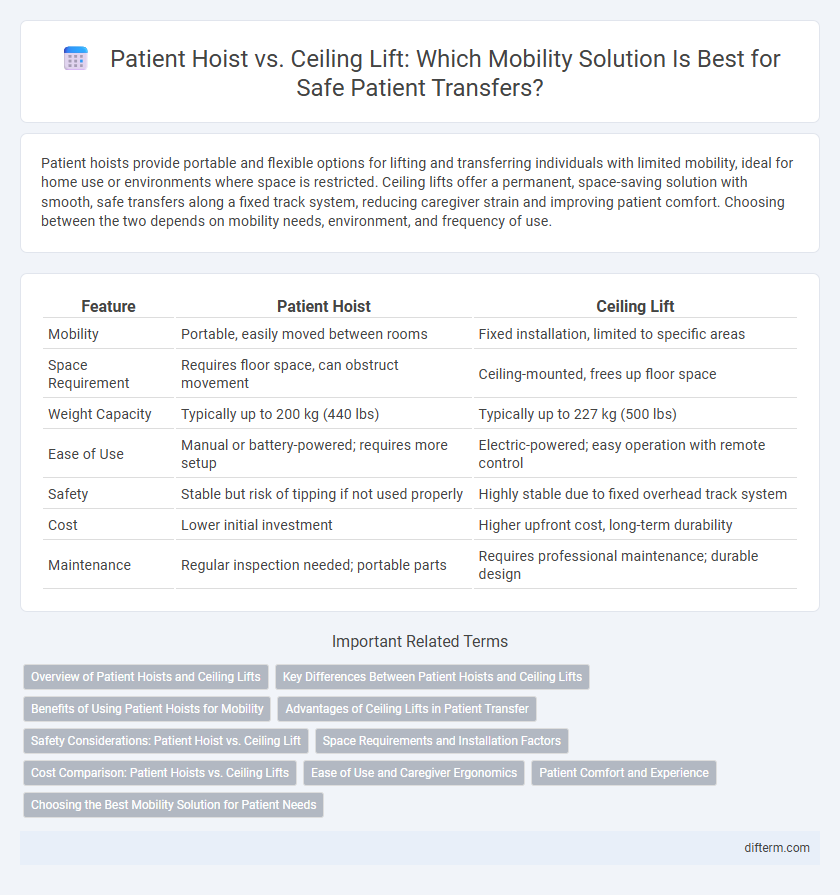Patient hoists provide portable and flexible options for lifting and transferring individuals with limited mobility, ideal for home use or environments where space is restricted. Ceiling lifts offer a permanent, space-saving solution with smooth, safe transfers along a fixed track system, reducing caregiver strain and improving patient comfort. Choosing between the two depends on mobility needs, environment, and frequency of use.
Table of Comparison
| Feature | Patient Hoist | Ceiling Lift |
|---|---|---|
| Mobility | Portable, easily moved between rooms | Fixed installation, limited to specific areas |
| Space Requirement | Requires floor space, can obstruct movement | Ceiling-mounted, frees up floor space |
| Weight Capacity | Typically up to 200 kg (440 lbs) | Typically up to 227 kg (500 lbs) |
| Ease of Use | Manual or battery-powered; requires more setup | Electric-powered; easy operation with remote control |
| Safety | Stable but risk of tipping if not used properly | Highly stable due to fixed overhead track system |
| Cost | Lower initial investment | Higher upfront cost, long-term durability |
| Maintenance | Regular inspection needed; portable parts | Requires professional maintenance; durable design |
Overview of Patient Hoists and Ceiling Lifts
Patient hoists and ceiling lifts are essential mobility devices designed to assist in safe patient transfers, reducing caregiver strain and enhancing patient comfort. Patient hoists typically offer portability with a freestanding frame and hydraulic or electric lifting mechanisms, ideal for moving patients between beds, chairs, and wheelchairs. Ceiling lifts, mounted on overhead tracks, provide a permanent solution with smooth, unobstructed movement across multiple rooms, optimizing space and improving transfer efficiency in healthcare settings.
Key Differences Between Patient Hoists and Ceiling Lifts
Patient hoists typically offer portability and can be moved throughout different rooms, making them ideal for home care settings, while ceiling lifts are permanently installed, providing smooth, hands-free transfers in hospitals and long-term care facilities. Ceiling lifts often support higher weight capacities and enhance safety by reducing caregiver strain, whereas patient hoists require manual operation and may limit caregiver mobility during transfers. The choice hinges on specific mobility needs, space availability, and the frequency of patient transfers within the care environment.
Benefits of Using Patient Hoists for Mobility
Patient hoists enhance mobility by providing safe and efficient transfers for individuals with limited movement, reducing the risk of injury to both patients and caregivers. These devices offer versatility in various settings, including homes, hospitals, and care facilities, supporting diverse patient needs with adjustable lifting capacities and user-friendly controls. Patient hoists can improve patient comfort and dignity during transfers, facilitating greater independence and smoother rehabilitation processes.
Advantages of Ceiling Lifts in Patient Transfer
Ceiling lifts provide superior space utilization by operating overhead, freeing floor area for caregivers and equipment, which enhances safety during patient transfers. They offer greater stability and smooth movement, reducing the risk of injury for both patients and healthcare providers compared to patient hoists. Integration with room layouts and automated control systems in ceiling lifts enables seamless, ergonomic, and efficient patient handling in medical facilities.
Safety Considerations: Patient Hoist vs. Ceiling Lift
Patient hoists offer enhanced maneuverability and are suitable for confined spaces, but require careful handling to avoid tipping hazards. Ceiling lifts provide superior stability and reduce fall risk by securely suspending patients, minimizing strain on caregivers during transfers. Both systems must comply with weight capacity limits and undergo regular maintenance to ensure optimal safety standards.
Space Requirements and Installation Factors
Patient hoists require designated floor space for maneuverability and storage, potentially limiting room layout flexibility, while ceiling lifts free up floor area by integrating into the overhead structure. Ceiling lifts demand professional installation involving ceiling reinforcement and precise planning for track placement, whereas patient hoists offer greater portability with minimal setup. Evaluating spatial constraints and installation complexity is crucial for selecting the optimal mobility solution in healthcare environments.
Cost Comparison: Patient Hoists vs. Ceiling Lifts
Patient hoists generally have a lower upfront cost compared to ceiling lifts, making them more accessible for short-term use or smaller budgets. Ceiling lifts require a higher initial investment due to installation and structural modifications but offer long-term savings by reducing caregiver strain and improving patient transfers. Maintenance expenses tend to be similar, though ceiling lifts often provide greater durability and reliability over time, potentially offsetting higher installation costs.
Ease of Use and Caregiver Ergonomics
Patient hoists offer portability and straightforward setup, enabling caregivers to assist transfers with minimal strain in various locations. Ceiling lifts provide superior ease of use by allowing smooth, hands-free operation, reducing caregiver fatigue and promoting better ergonomics during patient movement. Both systems enhance safety, but ceiling lifts excel in consistent support and minimizing physical effort for caregivers in clinical and home care settings.
Patient Comfort and Experience
Patient hoists provide versatile mobility support but may cause discomfort due to harness pressure and limited movement freedom. Ceiling lifts offer a smoother, quieter transfer experience with fewer physical constraints, enhancing patient relaxation and reducing anxiety. Their fixed installation allows continuous support without obstructing floor space, improving overall comfort during transfers.
Choosing the Best Mobility Solution for Patient Needs
Patient hoists offer versatile, portable mobility assistance ideal for varied locations and quick transfers, while ceiling lifts provide permanent, space-saving support with smooth, stable movement tailored to frequent use. Choosing the best mobility solution involves assessing the frequency of transfers, available space, patient weight, and caregiver accessibility. Evaluating these factors ensures optimal safety, comfort, and efficiency in patient handling and mobility management.
patient hoist vs ceiling lift Infographic

 difterm.com
difterm.com